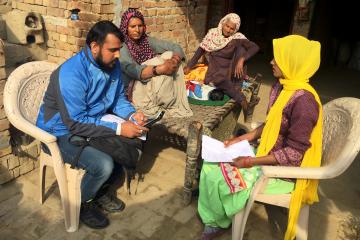
Strengthening immunization demand and delivery: Lessons from existing evidence

Vaccines are one of the most impactful and cost-effective public health commodities, responsible for protecting millions of people every year against various infectious diseases such as polio, measles, and, most recently, Covid-19. However, the Covid-19 pandemic has caused major disruptions to routine vaccination services around the world. Estimates in September 2020 suggested that routine immunization coverage for children in 2020 fell to rates last seen 25 years ago.
The J-PAL Health sector team has published a new evidence note that provides an overview of policy lessons stemming from economic research on improving immunization coverage. It focuses on improving the availability and accessibility of vaccines, as well as on increasing their demand. The lessons hold valuable insights on how best to increase Covid-19 vaccination coverage and routine immunization.
Halting global progress
Even prior to the pandemic, global immunization progress had stagnated for many vaccines. Over the past ten years, coverage of established, routine vaccines, such as those protecting against measles, polio, diphtheria, tetanus, and pertussis, had stalled at roughly 85 percent. In 2019, 19.7 million children were not fully immunized. Of those, 14 million children were “zero-dose,” having not received an initial dose of DPT (diphtheria, tetanus, and pertussis).
Meanwhile, governments, global health organizations, civil society members, and more are ramping up Covid-19 vaccination efforts with an eye towards ending the pandemic. COVAX, coordinated by Gavi, the Vaccine Alliance, the Coalition for Epidemic Preparedness Innovations, and the World Health Organization, has served as a groundbreaking global effort to accelerate the development, production, and equitable distribution of the vaccines. As of August 6, 2021, 4.4 billion doses of Covid-19 vaccines have been administered globally.
Despite major accomplishments, Covid-19 vaccine rollouts continue to face challenges. Vaccine shortages have prevented widespread access, particularly in many low- and middle-income countries. Vaccine hesitancy and refusal are also widespread.
Increasing availability of vaccines
Once procurement challenges are overcome, ensuring vaccines are reliably and locally available with well-motivated health workers can increase immunization rates. In particular, research has shown that reducing the physical distance to care through mobile outreach and other services can greatly increase the adoption of healthy behaviors, including vaccination.
Similarly, monitoring and performance-based incentives can help motivate health workers and improve performance in some contexts. However, interventions to increase provider effort are insufficient, and can even backfire, in contexts where the main barrier is household demand. Read more in the full evidence note.
Increasing demand for immunization
Even when vaccines are readily available and provided free of charge, several factors may make it difficult for caregivers to fully vaccinate their children or for adults to get vaccinated against diseases such as seasonal influenza and Covid-19.
Such barriers include lack of or inaccurate information, lack of trust, the low private benefits of immunization relative to the overall societal gains from herd immunity, and behavioral biases. Well-designed information campaigns, nudges, small incentives, and trust-building policies can address these barriers to increase demand for immunizations.
This note provides more details on these and other interventions, including important design elements and summaries of studies from which the lessons originated. However, it does not tailor recommendations to specific contexts or provide details on implementation. Rather, we encourage policymakers to reach out to Anupama Dathan, J-PAL Health Sector manager, for follow-up conversations on incorporating the evidence into policy decisions.






